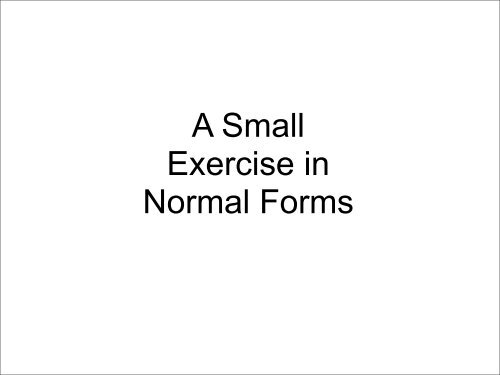Normal Forms example
Normal Forms example
Normal Forms example
You also want an ePaper? Increase the reach of your titles
YUMPU automatically turns print PDFs into web optimized ePapers that Google loves.
A Small<br />
Exercise in<br />
<strong>Normal</strong> <strong>Forms</strong>
Maple without Worms
Maple with Worms
Earthworm Invasions<br />
Study to identify the cause and extent of exotic earthworm<br />
infestations<br />
• Many sample sites, 10 meters in diameter, over a range of<br />
conditions. The worms present were counted and<br />
identified by species. GPS location was taken along with<br />
the type of soil, amount/depth of forest litter and<br />
vegetation at each sample site is also noted.<br />
• 5 different Earthworm species are found in varying<br />
amounts at each site<br />
• These data were organized in an attribute data file<br />
associated with each sampling point
Exotic Earthworm Study<br />
Non-normalized Form<br />
Repeat columns<br />
Site Table
<strong>Normal</strong> <strong>Forms</strong> Summary<br />
No repeat columns (create new records such<br />
that there are multiple records per entry)<br />
Split the tables, so that all non-key attributes<br />
depend on a primary key.<br />
Split tables further, if there are transitive<br />
functional dependencies. This results in tables<br />
with a single, primary key per table.
Un-normalized File<br />
Class Exercise Only (not to be turned in)<br />
Retain for Exam Study
You remove duplicate columns to create a 1st normal form
1st normal form<br />
– no repeat columns
2nd normal form<br />
Functional Dependencies<br />
Site/Species/Count<br />
Table<br />
Break up the 1 st normal table. Retain the<br />
Site/Species/Count table and create a second table<br />
with eight items, using Site as the primary key and<br />
removing the dependent items from the 1st NF table<br />
Site Table
2nd normal form<br />
Functional Dependencies<br />
Site/Species/Count<br />
Table<br />
Break up the 1 st normal table. Retain the<br />
Site/Species/Count table and create a second table<br />
with eight items, using Site as the primary key and<br />
removing the dependent items from the 1st NF table<br />
Site Table
2 nd normal form<br />
Functional Dependencies,<br />
Site -> East, North, Vegcode, Vegetation, soil, description, litter<br />
So I make a second table with these eight items, with Site as the<br />
primary key and remove the dependent items from the 1 st NF table<br />
Site table
3nd normal form - Transitive Functional Dependencies<br />
Veg-code -> Vegetation<br />
Soil -> Description<br />
Site/Species/Count<br />
Table<br />
Split the 2 nd normal table these into several tables, and<br />
removing the transitively dependent columns from the<br />
site table.<br />
Veg Table<br />
Site/CodeTable<br />
Soil Table
3nd normal form - Transitive Functional Dependencies<br />
Veg-code -> Vegetation<br />
Soil -> Description<br />
So split these into their own<br />
tables, and remove the<br />
transitively dependent<br />
columns from the site table,<br />
above<br />
Site/<br />
CodeTabl<br />
e<br />
Vegetation Table<br />
Soil Table
Exotic Earthworm Study 3rd <strong>Normal</strong> Form<br />
Site/Code Table<br />
Site/<br />
Species/<br />
Count<br />
Table<br />
Vegetation Table<br />
Soil Table

















